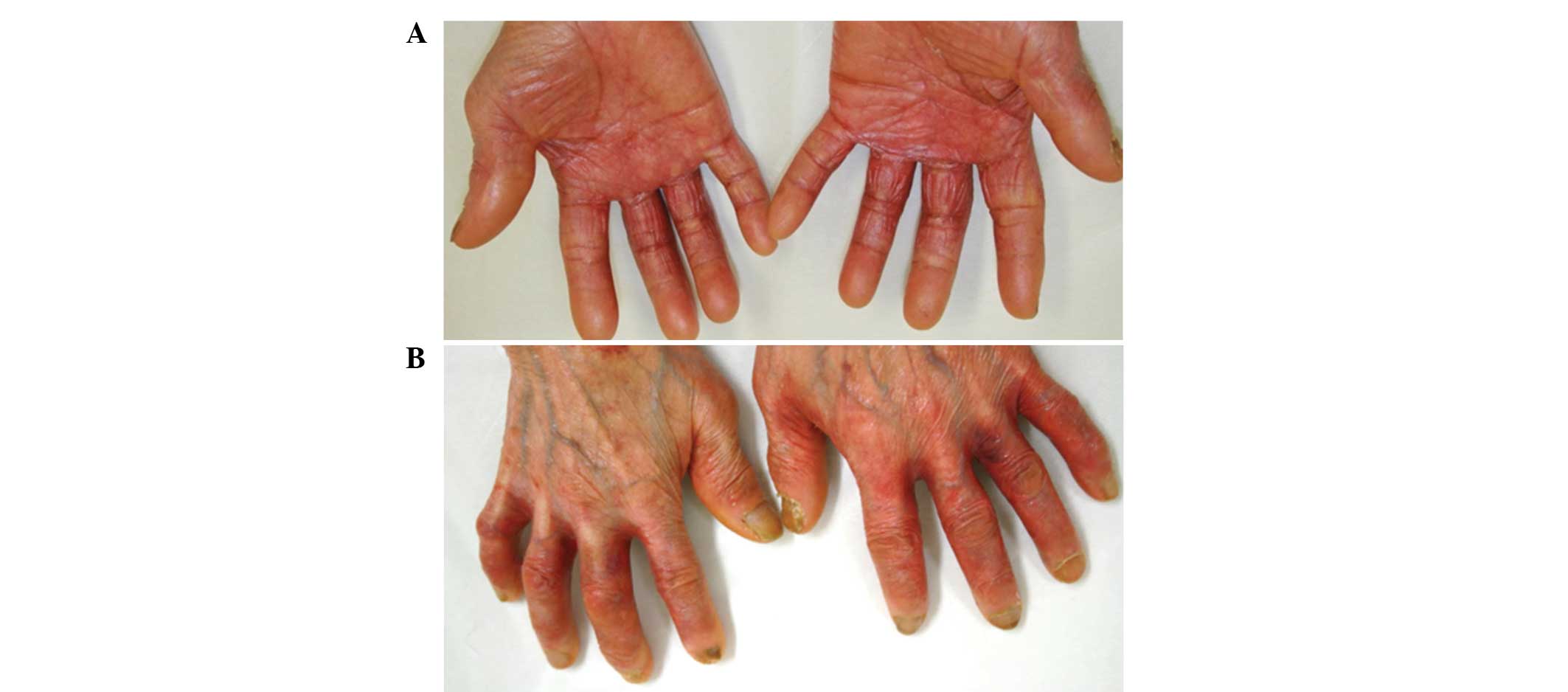|
1
|
Shimma N, Umeda I, Arasaki M, et al: The
design and synthesis of a new tumor-selective fluoropyrimidine
carbamate, capecitabine. Bioorg Med Chem. 8:1697–1706. 2000.
View Article : Google Scholar : PubMed/NCBI
|
|
2
|
Webster-Gandy JD, How C and Harrold K:
Palmar-plantar erythrodysesthesia (PPE): a literature review with
commentary on experience in a cancer centre. Eur J Oncol Nurs.
11:238–246. 2007. View Article : Google Scholar
|
|
3
|
Lassere Y and Hoff P: Management of
hand-foot syndrome in patients treated with capecitabine (Xeloda).
Eur J Oncol Nurs. 8(Suppl 1): S31–S40. 2004. View Article : Google Scholar : PubMed/NCBI
|
|
4
|
Asgari MM, Haggerty JG, McNiff JM,
Milstone LM and Schwartz PM: Expression and localization of
thymidine phosphorylase/platelet-derived endothelial cell growth
factor in skin and cutaneous tumors. J Cutan Pathol. 26:287–294.
1999. View Article : Google Scholar
|
|
5
|
Mrozek-Orlowski ME, Frye DK and Sanborn
HM: Capecitabine: nursing implications of a new oral
chemotherapeutic agent. Oncol Nurs Forum. 26:753–762.
1999.PubMed/NCBI
|
|
6
|
Wang F, Liu R, Lee SW, Sloss CM, Couget J
and Cusack JC: Heparin-binding EGF-like growth factor is an early
response gene to chemotherapy and contributes to chemotherapy
resistance. Oncogene. 26:2006–2016. 2007. View Article : Google Scholar
|
|
7
|
Piérard GE, Piérard-Franchimont C, Paquet
P and Quatresooz P: Spotlight on adapalene. Expert Opin Drug Metab
Toxicol. 5:1565–1575. 2009.
|
|
8
|
Rittié L, Varani J, Kang S, Voorhees JJ
and Fisher GJ: Retinoid-induced epidermal hyperplasia is mediated
by epidermal growth factor receptor activation via specific
induction of its ligands heparin-binding EGF and amphiregulin in
human skin in vivo. J Invest Dermatol. 126:732–739. 2006.
|
|
9
|
Shirakata Y, Kimura R, Nanba D, et al:
Heparin-binding EGF-like growth factor accelerates keratinocyte
migration and skin wound healing. J Cell Sci. 118:2363–2370. 2005.
View Article : Google Scholar : PubMed/NCBI
|
|
10
|
Fabian CJ, Molina R, Slavik M, Dahlberg S,
Giri S and Stephens R: Pyridoxine therapy for palmar-plantar
erythrodysesthesia associated with continuous 5-fluorouracil
infusion. Invest New Drugs. 8:57–63. 1990. View Article : Google Scholar
|
|
11
|
Yoshimoto N, Yamashita T, Fujita T, et al:
Impact of prophylactic pyridoxine on occurrence of hand-foot
syndrome in patients receiving capecitabine for advanced or
metastatic breast cancer. Breast Cancer. 17:298–302. 2010.
View Article : Google Scholar
|
|
12
|
Kang YK, Lee SY, Cheon YJ, et al:
Pyridoxine is not effective for the prevention of
capecitabine-induced hand foot syndrome (HFS): Results of a
randomized double-blind placebo-controlled study. Ann Oncol.
17:286–287. 2006.
|
|
13
|
Kang YK, Lee SS, Yoon DH, et al:
Pyridoxine is not effective to prevent hand-foot syndrome
associated with capecitabine therapy: results of a randomized,
double-blind, placebo-controlled study. J Clin Oncol. 28:3824–3829.
2010. View Article : Google Scholar
|
|
14
|
Zhang RX, Wu XJ, Wan DS, et al: Celecoxib
can prevent capecitabine-related hand-foot syndrome in stage II and
III colorectal cancer patients: result of a single-center,
prospective randomized phase III trial. Ann Oncol. 23:1348–1353.
2012. View Article : Google Scholar
|
|
15
|
Wolf SL, Qin R, Menon SP, et al; Cancer
Treatment Group Study N05C5. Placebo-controlled trial to determine
the effectiveness of a urea/lactic acid-based topical keratolytic
agent for prevention of capecitabine-induced hand-foot syndrome:
North Central Cancer Treatment Group Study N05C5. J Clin Oncol.
28:5182–5187. 2010. View Article : Google Scholar
|
|
16
|
Darlenski R, Surber C and Fluhr JW:
Topical retinoids in the management of photodamaged skin: from
theory to evidence-based practical approach. Br J Dermatol.
163:1157–1165. 2010. View Article : Google Scholar : PubMed/NCBI
|
|
17
|
Suganuma K, Kubota T, Saikawa Y, et al:
Possible chemoresistance-related genes for gastric cancer detected
by cDNA microarray. Cancer Sci. 94:355–359. 2003. View Article : Google Scholar
|
|
18
|
DeWitt CA, Siroy AE and Stone SP:
Acneiform eruptions associated with epidermal growth factor
receptor-targeted chemotherapy. J Am Acad Dermatol. 56:500–505.
2007. View Article : Google Scholar : PubMed/NCBI
|
|
19
|
Hachisuka J, Doi K, Moroi Y and Furue M:
Successful treatment of epidermal growth factor receptor
inhibitor-induced periungual inflammation with adapalene. Case Rep
Dermatol. 3:130–136. 2011. View Article : Google Scholar
|
|
20
|
Geyer CE, Forster J, Lindquist D, et al:
Lapatinib plus capecitabine for HER2-positive advanced breast
cancer. N Engl J Med. 355:2733–2743. 2006. View Article : Google Scholar
|
|
21
|
Fuchs E and Raghavan S: Getting under the
skin of epidermal morphogenesis. Nat Rev Genet. 3:199–209. 2002.
View Article : Google Scholar : PubMed/NCBI
|
|
22
|
Mukherjee S, Date A, Patravale V, Korting
HC, Roeder A and Weindl G: Retinoids in the treatment of skin
aging: an overview of clinical efficacy and safety. Clin Interv
Aging. 1:327–348. 2006. View Article : Google Scholar : PubMed/NCBI
|
|
23
|
Segaert S and Van Cutsem E: Clinical
signs, pathophysiology and management of skin toxicity during
therapy with epidermal growth factor receptor inhibitors. Ann
Oncol. 16:1425–1433. 2005. View Article : Google Scholar
|
|
24
|
Lacouture ME: Mechanisms of cutaneous
toxicities to EGFR inhibitors. Nat Rev Cancer. 6:803–812. 2006.
View Article : Google Scholar : PubMed/NCBI
|
















